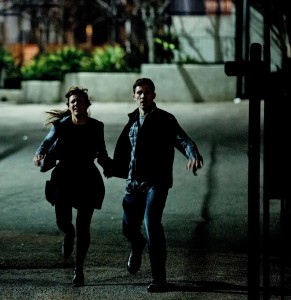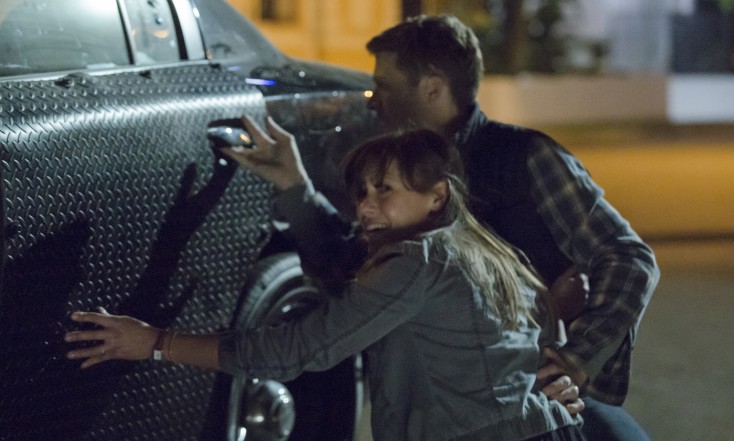
Liz (KIELE SANCHEZ) and husband Shane (ZACH GILFORD) try to survive the night in “The Purge: Anarchy.” ©Universal Pictures. CR: Justin Lubin.
By PETERSON GONZAGA
Front Row Features
HOLLYWOOD—Best known for playing star quarterback Matt Saracen on the NBC drama series “Friday Night Lights,” actor Zach Gilford has been doing more and more film work. In 2009, he co-starred with Alexis Bledel in the romantic comedy “Post Grad.” More recently, Gilford was featured in the horror film “Devil’s Due.”
In “The Purge: Anarchy,” opening Friday, he returns to the horror/suspense genre, alongside his real-life wife Kiele Sanchez.
In the sequel to surprise 2013 box office hit “The Purge,” (both of which were written and directed by James DeMonaco), Gilford plays Shane and Sanchez plays Liz, a couple on the verge of separating, when they become the victims of a carjacking right before the annual purge begins.
During a recent press junket and special The Purge: Anarchy Experience, where participants (sort of) get to act out the movie, in downtown Los Angeles, Gilford spoke about working with his wife onscreen, some of the obstacles they faced on set and his personal views about guns.
Q: Did you do The Purge Anarchy Experience?
Gilford: I did it in Atlanta. It’s so fun.
Q: Are you good at it?
Gilford: We got it pretty close. I don’t think you could do it more than once. The girls are so awesome—the actresses in the experience. It’s such a delicate balance of how much to help and how much not to. I think they did a great job.
Q: What did you think of the idea of The Purge itself in murdering or anything you want to do in 12 hours?
Gilford: I thought it was a really cool commentary. Obviously, the first one was more focused on the inherently violent nature in people and given this opportunity, what would they do about it? I think one is more political as it gets you out on the street with everyone. Not just one family. It plays into the rich-get- richer and the poor-get-poorer (notion). If we keep heading in this direction, the rich can do whatever they want, take advantage of whomever they want and literally kill them, while poor people are trying to protect their lives.
Q: Do you think it’s about giving some sense of false empowerment to these people?
Gilford: It’s like this messed up thing we do where we give these programs to make these people empowered, but we’re putting so little effort and energy in those programs. It’s like we’re giving them crumbs instead of getting behind them. It seems like we’re really getting behind programs that make a lot of money and help keep things the way they are.
Q: How did you guys create the tension mentally and be in the moment on set?
Gilford: It’s really funny. On a movie like this, when you’re down the street with a machine, you kind of get into it, like play make-believe like that 7-year-old who could pretend that couch cushion was an airplane. Somehow we could pretend that someone’s there to kill us and we’re really going to die. When you’re on these sets in downtown L.A., when everyone else is doing it, you go along with it and get into it. It’s kind of fun.
Q: You’re and Kiele Sanchez are a real-life couple, and you play a couple onscreen. How did the audition go? Did they know you were related?
Gilford: They didn’t know. We told them. It was coincidental. We told them during the process. But they had no idea. It just kind of worked out. It was really fun. Making a movie is kind of like going to summer camp and you have these experiences. You come home and you’re like, “I did this and it was so much fun,” and nobody cares. It’s the same way you make a movie and come home and tell your wife, and she’s like “Who cares?” But we got to do it together, and it was really special. It’s funny that “The Purge: Anarchy” is something we have special together. It’s a very romantic movie.
Q: Does night shooting affect your psyche?
Gilford: Totally. After you’ve done one, your first job ever, it throws off your whole clock. It definitely helps the scenes (though), because it’s 4 a.m., and you haven’t seen daylight in days and it just clicks you into that zombie-like quality. You definitely get use to it but it helps play into what you’re going through.
Q: How long did it take to shoot the movie?
Gilford: I think the movie was a 30-day shoot of the night. We had two weeks of nights and the rest were mostly splits. You’d be up until 3 a.m.
Q: It must mess your body clock up?
Gilford: Yeah. You want a prescription of Ambien and a lot of caffeine at home. It’s hard shooting in L.A., if you live here. When you’re on location, you can just pull the hotel curtains and you have no responsibilities. But here, I still have to clean the house. I still have to walk the dog. I still have to pick up the dry cleaning. It’s weird. Life is still going. It was really different than any other night shoot I’ve done.
Q: There are some scary parts of downtown L.A. Was it scary shooting there?
Gilford: The scariest area was an alleyway that we shot in. It was completely rat-infested and happened to be in a scene where a rat jumped on Kiele’s leg. That was a trained rat. Before the scene, we literarily would scare the rats away and as the scene went on, they would get closer and closer. We’d leave the scene and then we’d scare them away again. Pretty terrifying. Besides that, there was one scene we were shooting where some drunk dude literarily walked through our lockup and right through our set and peed against the building. We were like, “Do we still have to work right here?” It was so weird. Everybody was like, “Really?” The guy says, “What? I had to go.”
Q: Was this your first time handling guns?
Gilford: No. I’ve handled guns in movies before. My wife, Kiele, hated it. Even when we had the rubber guns, she would say, “Don’t point that at me!” I said, “It’s rubber!” She’d say, “Just don’t!” But it’s weird. I shot that big machine gun and, not to get political, I was like “Why would anyone need something like this?” No good comes from this thing. It’s funny, on one movie set, they told me it looks like I know how to use a gun.
Q: Did you shoot the movie chronologically?
Gilford: A lot of it. But we couldn’t do all of it (in sequence) because there wasn’t enough time to shoot everything that long. We did most of the movie chronologically, which kind of helps because you’re building on what you’ve already done as opposed to jumping from sequence to sequence.





